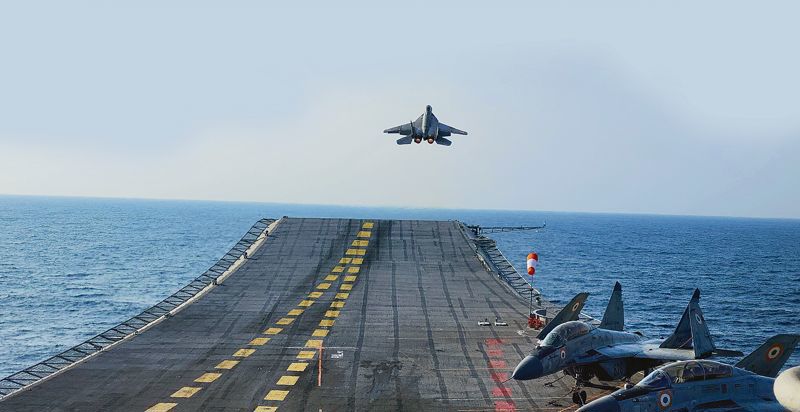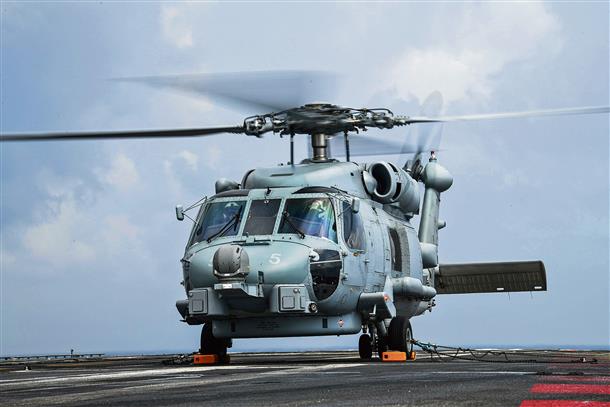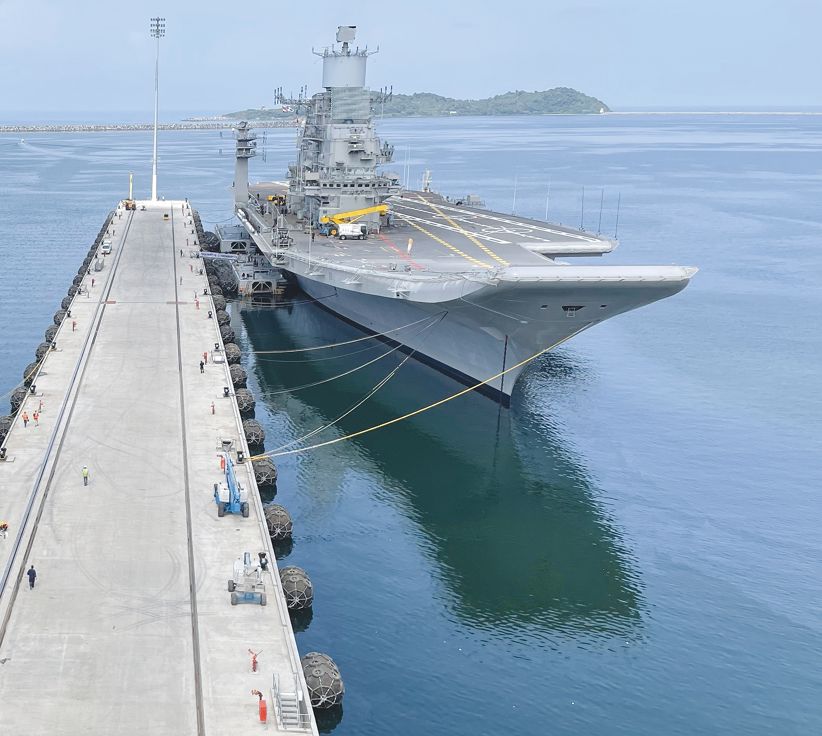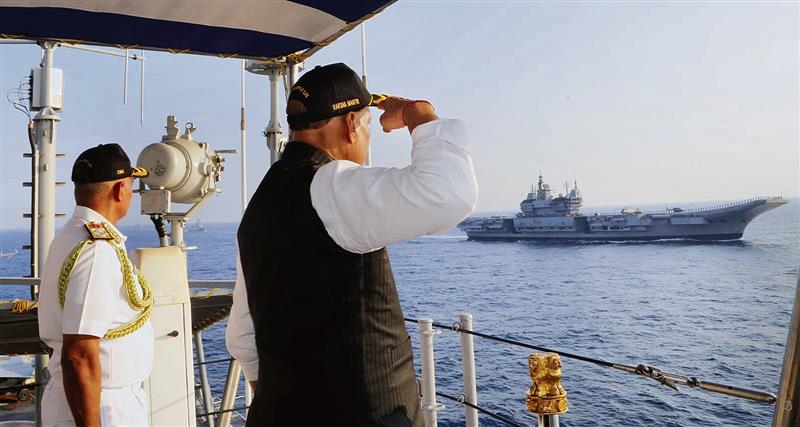In the first week of March itself, the Indian Navy has seen a string of capability additions, catering to the immediate and long-term maritime objectives. The rapid progress sends positive signals, but challenges remain

Ajay Banerjee
THE enhancement of the Indian Navy’s capabilities, announced in the first week of March, signals an expansion matching New Delhi’s strategic aspirations in the Indian Ocean. It is also an indication of India’s immediate and long-term maritime objectives.

Karwar in northern Karnataka got a major infrastructure boost and is now the biggest naval base of the country. The latest technology-capable submarine-hunting helicopters, the MH-60R, were commissioned at Kochi. A new base, INS Jatayu, got commissioned at Minicoy in Lakshadweep. It sits close to the ‘9 degree shipping channel’, the busiest sea route to Europe and the Middle East in its westerly direction and China, Japan, Korea, among others, to its east.

Amid this, the Navy carried out simultaneous copter and jet flying operations from both aircraft carriers — the INS Vikramaditya and INS Vikrant — for Defence Minister Rajnath Singh to assess the readiness. Twin-carrier operations have been done in the past, the most recent being in June last year. However, this time, INS Vikrant has been fully integrated with the rest of the fleet and its final flight integration is being done.
Also, after June last year, the Vikrant underwent a re-fit and re-started sailing in January. Medium-range surface-to-air missiles Barak-8 and MF-STAR (multi-function surveillance, track and guidance radar) have been fitted. The MF-STAR detects airborne threats like aircraft, anti-ship missiles and cruise missiles; the Barak-8 missile can shoot these at ranges of 80 km or more.

Expansion of Karwar base
Called Project Seabird, it is spread across 25 km and is being carried out in phases. The first phase was designed to accommodate 10 ships and it concluded in 2011. Phase II-A was okayed by the Cabinet Committee on Security in December 2012 to allow berthing of 32 ships and submarines, along with 23 yardcraft.
On March 5, Defence Minister Rajnath Singh, among other things, opened a 550-metre-long pier — that juts out into sea — to allow both aircraft carriers to berth at the same time at Karwar.

The INS Vikramaditya and INS Vikrant are the biggest warships in the fleet, each weighing close to 50,000 tonnes. The Vikramaditya is 284 metres long while the Vikrant is 262 metres long. The warships need a specific depth of water near the coast, while the length of the jetty and the pier needs to match their sizes when they dock for routine maintenance.
So far, Karwar had the facility to take in one carrier. The Cochin Shipyard has a facility to berth another carrier, but that is not a naval facility.
Vice Admiral Ravneet Singh (retd), former Deputy Chief of the Navy, who was Director General of Project Seabird for almost two years from 2018, says, “Things have made rapid progress. This is the biggest base for the Navy and will be its third operational base on the west coast.”
Phase II-A has a berthing space for ships and submarines that is collectively about 6 km in length. These jetties have technical facilities, electrical substations, switch gears and support utilities.
The latest Scorpene submarines will get a covered jetty to prevent enemy satellites from seeing how many subs are at base and how many are out at sea. A similar covered jetty exists on the east coast at Visakhapatnam.
Among the facets at Karwar is a covered dry berth, standing at a height of 75 metres, taller than the Qutub Minar in Delhi, and spread over 33,000 square metres to facilitate simultaneous maintenance of four frontline ships.
Phase II-A will also have four townships encompassing residential accommodation, with about 10,000 dwelling units for officers, sailors and civilian staff. The hospital is being upgraded to have 400 beds.
“The upcoming greenfield dual-use Naval Air Station with a 2.7-km runway will provide air support to the Navy aircraft and facilitate operations of commercial aviation,” adds Admiral Ravneet Singh.
The Navy hopes to ink its contract in a year and plans to have a fully operational airfield in four years.
About 90 per cent of the materials and equipment are being sourced from within the country. The project’s execution involves Indian infrastructure leaders such as AECOM India Ltd, Larsen & Toubro, ITD Cementation India Ltd, Nagarjuna Construction Company, Navayuga Engineering Company Ltd and Shapoorji Pallonji Group.
The latest copters
Indian Navy’s first MH-60R squadron has been commissioned as INAS 334 ‘Seahawks’ at INS Garuda, Kochi. This brings transformational anti-submarine (ASW) and anti-surface warfare (ASuW) capabilities to the Indian Navy. China has a fleet of some 60 such under-sea submarines that often trawl the Indian Ocean.
The helicopters would widen the arc of Navy’s capabilities, extending its operational reach. Vice Admiral Biswajit Dasgupta (retd), a former Eastern Navy Commander, says, “The helicopters will substantially enhance the combat power of our fleets in the coming days. They are of proven design and will become the mainstay of the Navy’s ship-borne air operations across warfare domains such as anti-submarine warfare, anti-ship warfare and surveillance, besides other lower-end roles.”
The copter uses a performance-based logistics programme for the US Navy which enables 95 per cent flight readiness and availability of the copter — a rate unmatched by other maritime helicopters. The US Navy and its allies use the same copter. Secondary roles for the copter include naval surface fire support, medical evacuation, search and rescue, logistics, special warfare, intelligence, surveillance and reconnaissance.
MH-60R is built based on four decades of operational experience of US company Lockheed Martin. India and the US signed a 24-copter contract in February 2020 at a cost of nearly Rs 14,000 crore under the framework of foreign military sales. All 24 helicopters are scheduled for delivery by 2025.
The helicopter is the maritime variant of the Blackhawk helicopter used by US forces. The Blackhawk was famously used by the US in an air raid in May 2011 to kill Osama bin Laden in Abbottabad, Pakistan.
Upgrade over Kamov
The Indian Navy, so far, is using the Russian origin Kamov-28 copters for anti-submarine roles. The Kamov is more than three decades’old technology but is equipped with torpedoes, depth charges and the copters have been with the Navy for almost 25 years.
Comparing the MH-60R with Kamov-28, Admiral Ravneet Singh says, “As compared to MH-60R, the Kamov, in its present configuration, lags behind in operational effectiveness as its equipment now falls under vintage technology. The Kamov, due to its size and weight, can be operated from very limited frontline ships. The availability of spares and the maintenance have been a challenge. It does not have the capability to dunk sonars at sea at night, which is a big capability gap.”
The technical life extension of the Kamov is being done in Russia and it’s being upgraded with an advanced maritime mission suite being added in India. The modernisation package includes the integration of advanced mission systems, sensors and avionics, anti-ship missiles as well as other weapons and also sonar dunking ability at night.
Watching shipping lanes
The Minicoy Island is the southern-most island of Lakshadweep, situated at a distance of 398 km south-west of Kochi. The Minicoy sits south of the 9 degree shipping channel. Maldives is just 130 km further south of Minicoy.
The INS Jatayu, that was commissioned by Navy Chief Admiral R Hari Kumar, has advanced surveillance capabilities. New jetties, an airfield and BrahMos supersonic cruise missiles are to be added.
The BrahMos missiles, with their latest versions being able to strike 500 km away, will enhance India’s ability to deter potential threats and safeguard vital shipping lanes.
The establishment of a naval base at Minicoy will augment connectivity with the mainland, focusing on comprehensive development of the islands.
Bolster maritime security
Development of our islands for maritime security should have been done decades ago. The US and France have strong island bases like Hawaii and Reunion, respectively. If India does not strengthen the Andaman and Nicobar Islands manifold and rapidly develop Lakshadweep and Minicoy to bolster maritime security, it would be throwing away the strategic advantage bestowed by geography. Vice Admiral Biswajit Dasgupta (Retd)
Admiral Dasgupta says, “We must bring with it a rapid development of staging or turnaround facilities for naval ships and aircraft. Only then will it provide benefits in terms of forward surveillance, presence and extended reach.”
Customarily, Indian Navy’s air stations are named after birds of prey. So one would expect an airfield to come up in quick time at Minicoy, that will allow the Navy to operate its patrol and remotely-piloted aircraft, avers Admiral Dasgupta.
How MH-60R functions
- The fully-integrated mission system processes data from onboard sensors to build a complete situational picture of the ocean surface and under-sea.
- The knowledge available to the pilots enables tackling the threat.
- It can dunk a sonar into sea and scan underwater presence of submarines.
- The crew can track, target and engage ships or submarines.
- Weapons include torpedo and air-to-ground missiles like ‘Hellfire’.
- Pilots are equipped with night-vision goggles for night flying. During daytime, the display for the pilot is readable despite sunlight.
- Advanced digital sensors provide warning against approaching missiles, location of enemy radars.
- Electro-optical and infrared camera will use secure data links to provide real-time imagery to base stations and warships.
